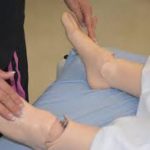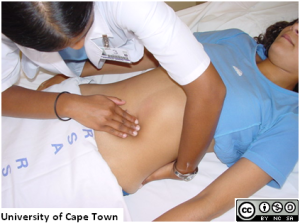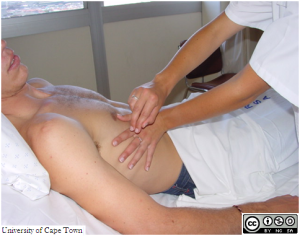
Objectives: At the end of this chapter, the learner will:
Overview of this chapter
The standard method of physical examination resolves around the following techniques. Inspection, which is considering clues from what we see. Palpation, gathering information from what we feel or what the patient feels as we palpate. Percussion, listening to different percussion notes and interpreting these in the context of the presenting complaint. Auscultation, using a stethoscope to listen more intensely to sounds within the body. All of these aspects of examination rely on a knowledge of what is normal in order to identify any abnormalities. Physical assessment also requires some knowledge of common patterns of presentation or manifestations associated with different conditions.
All of the information gathered during these four processes will add to clues and help nurses formulate nursing diagnoses or patient’s functional health problems. When we inspect our patient to discover relevant clues we look at the patient as a whole. Are they appropriately dressed for the current weather? Their demeanor? their expression? Does their facial expression indicate that they are in pain? Their gait? their body shape? If we are focused on specific systems, we may inspect one or more parts of the body related to that system.
Our hands can tell us many things about the body of the patient we are examining. As we shake hands with the patient at the beginning of the consultation we are aware if the patient’s hand is hot, which may indicate a fever, or cold, possible peripheral vascular problems, whether it is clammy, sepsis or cardiogenic shock. We can assess their muscle tone, limb weakness, or spasticity through palpation. All within the few short seconds of a handshake and as we move into specific system examinations we can palpate for tactile fremitus, respiratory, masses, abdomen or skin, pulses, circulation, lymph nodes, systemic infection or crepitus, musculoskeletal system.
One of the most difficult techniques for nurses to learn has been shown to be percussion of the body cavities. Percussion can give us clues to several health conditions by the change in the percussion note or sound when we percuss over solid, bone, tumor, fetus, feces, or fat or liquid, pleural effusion, urinary bladder ascites, or gas. Flatus, fully expanded lung tissue etc. The technique is to use the middle or index and middle fingers of your dominant hand as the drumstick and drop it smartly onto the middle phalanx of your non-dominant middle finger which rests on the patient’s body. The drum beat noise that this produces indicates whether solid, liquid or gas is present in that body cavity. Here are some examples of the sounds you could hear. Solid, over bone, liquid, over ascites, gas, over chest cavity.
Auscultation is the act of listening to body parts and assessing the sounds made using a stethoscope. There are several types of stethoscope and it is important to acquire a stethoscope which is appropriate to yourself and suitable for your patient group. For example, if you have a hearing deficit, an electrically amplified stethoscope may be useful for you. If you work mainly with babies and children, you may need a pediatric stethoscope which has a smaller head. You need to accustom yourself to your chosen stethoscope ensuring that the ear pieces are inserted pointing towards your face and not towards the back of your head. This way, they follow the ear canal and transmit sound more efficiently.
How to Perform the Techniques of Physical Examination
The order of physical assessment techniques usually occur in the following order: inspection, palpation, percussion, and auscultation. Use them in sequence—unless you’re performing an abdominal assessment. Palpation and percussion can alter bowel sounds, so you’d inspect, auscultate, percuss, then palpate an abdomen.
- Inspection
Inspect each body system using vision, smell, and hearing to assess normal conditions and deviations. Assess for color, size, location, movement, texture, symmetry, odors, and sounds as you assess each body system.
2. Palpation
Palpation requires you to touch the patient with different parts of your hands, using varying degrees of pressure. Because your hands are your tools, keep your fingernails short and your hands warm. Wear gloves when palpating mucous membranes or areas in contact with body fluids. Palpate tender areas last.
Light palpation
- Use this technique to feel for surface abnormalities.
- Depress the skin ½ to ¾ inch (about 1 to 2 cm) with your finger pads, using the lightest touch possible.
- Assess for texture, tenderness, temperature, moisture, elasticity, pulsations, and masses.
Deep palpation


- Use this technique to feel internal organs and masses for size, shape, tenderness, symmetry, and mobility.
- Depress the skin 1½ to 2 inches (about 4 to 5 cm) with firm, deep pressure.
- Use one hand on top of the other to exert firmer pressure, if needed.
3. Percussion
Percussion involves tapping your fingers or hands quickly and sharply against parts of the patient’s body to help you locate organ borders, identify organ shape and position, and determine if an organ is solid or filled with fluid or gas.
Direct percussion
This technique reveals tenderness; it’s commonly used to assess an adult’s sinuses.
- Using one or two fingers, tap directly on the body part.
- Ask the patient to tell you which areas are painful, and watch his face for signs of discomfort.
Indirect percussion
This technique elicits sounds that give clues to the makeup of the underlying tissue. Here’s how to do it:

- Press the distal part of the middle finger of your nondominant hand firmly on the body part.
- Keep the rest of your hands off the body surface.
- Flex the wrist of your nondominant hand.
- Using the middle finger of your dominant hand, tap quickly and directly over the point where your other middle finger touches the patient’s skin.
- Listen to the sounds produced.
4. Auscultation
Auscultation involves listening for various lung, heart, and bowel sounds with a stethoscope.
- Provide a quiet environment.
- Make sure the area to be auscultated is exposed (a gown or bed linens can interfere with sounds.)
- Warm the stethoscope head in your hand.
- Close your eyes to help focus your attention.
How to auscultate
- Use the diaphragm to pick up high-pitched sounds, such as first (S1) and second (S2) heart sounds. Hold the diaphragm firmly against the patient’s skin, using enough pressure to leave a slight ring on the skin afterward.
- Use the bell to pick up low-pitched sounds, such as third (S3) and fourth (S4) heart sounds. Hold the bell lightly against the patient’s skin, just hard enough to form a seal. Holding the bell too firmly causes the skin to act as a diaphragm, obliterating low-pitched sounds.
- Listen to and try to identify the characteristics of one sound at a time.
Learning Clinical ( Free) 2006. Assessing patients effectively: Here’s how to do the basic four techniques
